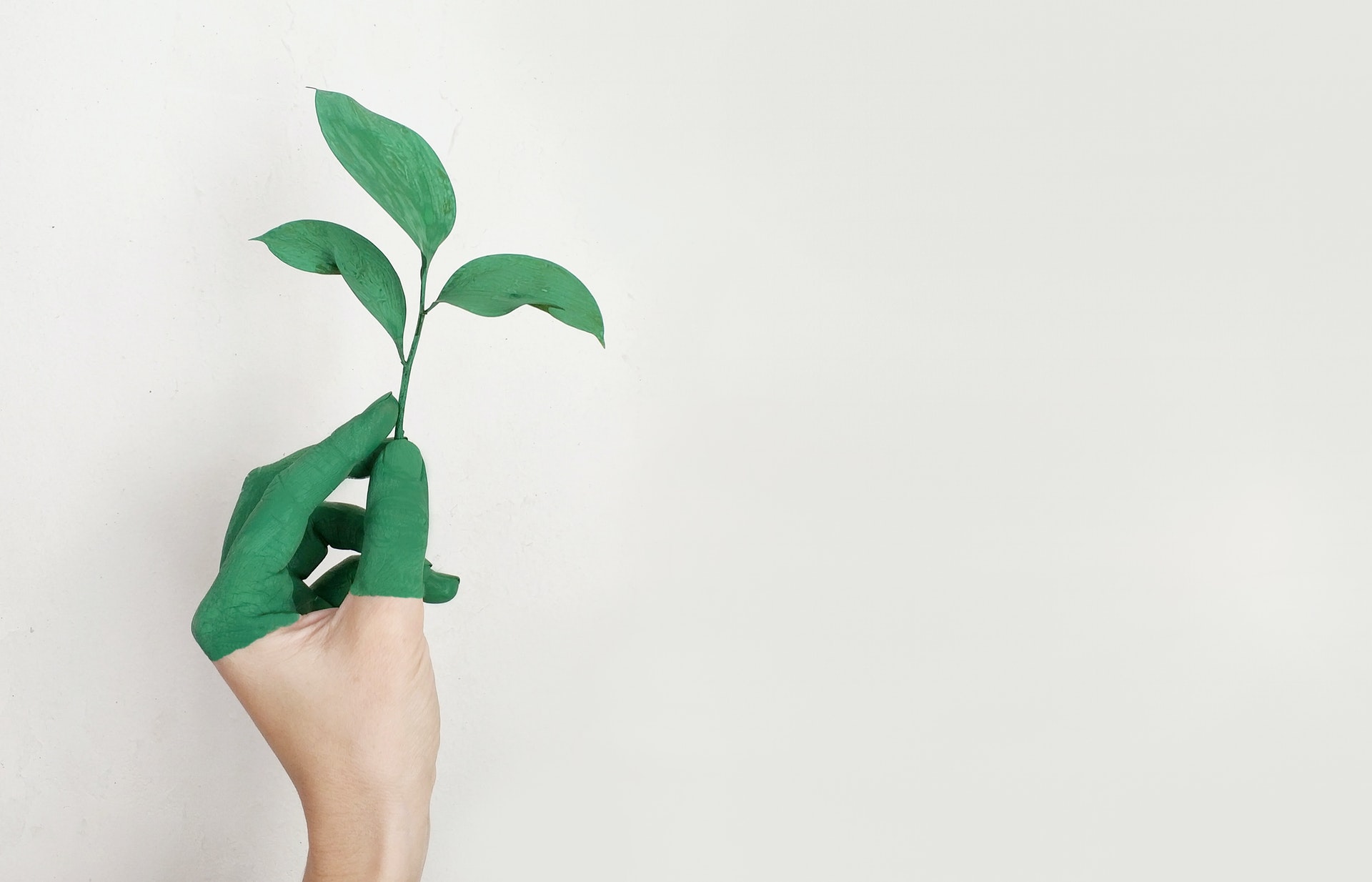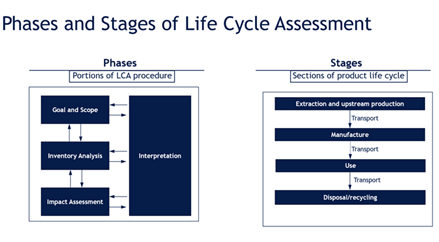 This page covers the below sections:
This page covers the below sections:
- Introduction to Life Cycle Analysis (LCA)
- Factors Within the LCA
- ISO Standards
- Resources
- Case Studies
- References
See the Contents for all available Sustainability Hub pages.
Introduction to Life Cycle Analysis (LCA)
Life Cycle Analysis or Assessment (LCA) is a method that can be used to evaluate the environmental impact of a product through its life cycle, encompassing extraction and processing of the raw materials, manufacturing, distribution, use, recycling, and final disposal(1).
Stakeholders, including shareholders, markets, and consumers, are increasingly demanding improved environmental performance and transparency. Companies are using LCA to help them demonstrate their commitments to a more sustainable future and to objectively measure their progress(2).
LCA can be used for many applications. It is mostly used to help identify the greatest impacts along the supply chain, establishing a baseline against which improvement can be measured. It can also be used to help guide the development of a product or process. Of course, it is also vital in helping support product and company environmental declarations(2).
Factors Within the LCA
The supply chains for the personal care industry can be long and complex. In our products we use a wide range of raw materials and packaging. A single product can contain ingredients from a variety of sources and different suppliers. Depending on the product type the direct packaging can be simple or complex. A foam bath, for example, could just be a bottle, cap, and label. Whereas an eyeshadow palette could be more complicated. For example, several eyeshadow powders in metal pans (godets) will be placed in a plastic case. The case might also contain a plastic insert into which the godets are placed. Quite often a mirror will also be included along with one or more applicators. The finished pack can be comprised of several different materials, a range of plastics, which could themselves be mixtures of different plastics, metal godets and the mirror. A full LCA for the eyeshadow palette would therefore be complicated.
In addition to the direct packaging, other factors such as the indirect packaging, transport and consideration of what happens when the product has been used by the consumer, means that for the personal care industry LCA can be a daunting prospect.
ISO Standards
The International Organisation for Standardisation (ISO) has published two standards on LCA.
ISO 14040:2006 describes the principles and framework for LCA including defining the goal and scope of an LCA, the life cycle inventory analysis (LCI) phase, the life cycle impact assessment (LCIA) phase, the life cycle interpretation phase, reporting and critical review of the LCA, limitations of the LCA, the relationship between the LCA phases, and conditions for use of value choices and optional elements. ISO 14040:2006 covers LCA studies and life LCI studies, it does not describe the LCA technique in detail and does not specify methodologies for the individual phases of the LCA(3). The first amendment to this ISO standard was published in September 2020(3).
Alongside ISO 14040:2006 is ISO 14044:2006, this specifies requirements and provides guidelines for LCA in addition to the phases described in ISO 14040:2006 it covers life cycle assessment (LCA) studies and life cycle inventory (LCI) studies(3). Both ISO standards and the amendment to ISO 14040:2006 can be purchased from ISO.
As indicated in the ISO standards there are a series of phases to completing an LCA:
Phase 1 - This phase involves setting the goal, which must state the intended use of the LCA, the reasons and audience for the study, whether it is comparative and whether it is to be disclosed to the public. Secondly the scope is determined, this includes the product system, the functions of the systems and the functional unit. This section also lays out the system boundary, allocates procedures, impact categories, assessment method and interpretation type(2).
Phase 2 – The LCI phase or data collection.
Phase 3 – The LCIA phase, which is the conversion of inventory data into environmental impact potentials. Phase 4 is the interpretation. This phase is continuous and can be used to help guide the other phases as data become available.

Courtesy of the Personal Care Products CouncilSocial LCA
Social Life Cycle Assessment (S-LCA) assesses social and socio-economic impacts found along the life cycle, from raw material extraction, processing, manufacture, use, end of life, using generic and site-specific data(5).
S-LCA is an impact assessment methodology that aims to assess the social and socio-economic aspects of products and their potential positive and negative impacts, along their life cycle. S-LCA can either be applied on its own or in combination with E-LCA (Environmental-LCA)(5).
S-LCA is largely based on the ISO 14040:2006 framework for E-LCA and introduces comparable phases, S-LCA (Social Life Cycle Inventory), S-LCIA (Social Life Cycle Impact Assessment) and Interpretation. It is an alternative methodology which goes through several assessment loops and moving from generic potential results to more site and case specific ones(6).
Impact categories in S-LCA include factors such as Human Rights, Working Conditions, Health and Safety, Cultural Heritage, Governance, and Socio-economic repercussions(6). The S-LCA impact subcategories are linked to 17 Sustainable Development Goals (SDGs)(6). These fit well with other initiatives in the personal care industry, such as those to prevent the use of child labour in the mica supply chain(7) and the Cocoa Livelihoods Program of the World Cocoa Foundation(8).
S-LCA can be used to help companies build a targeted strategy for future development of social policies as well as supporting decision-making processes that involve a number of different stakeholders with differing knowledge and backgrounds. It is also helpful for managing social risk, as social hotspots can be identified, as well as providing structure, credibility, and consistency to supply chain assessment. All these support an organisation’s disclosure of non-financial information(6).
Social organised life cycle analysis (SO-LCA) is based on the same concepts as S-LCA. The main difference between the methods is in the scope of the analysis(6). SO-LCA measures social indicators or impacts on the organisational level to assess the organisation’s social performance. It complements S-LCA by considering the organisation as a whole rather than from a pure product perspective(6).
Resources
Due to their complexity, conducting LCAs of the various types needed is likely to be a major project for companies to take on. A considerable amount of staff training will be needed, and it will take a lot of time to review all the data required and then generated. However, there are free resources available that can help with training.
If companies are interested in completing LCAs for their products and/or processes, but do not feel confident in doing this themselves, there is a wide range of companies offering their services on a consultancy basis. Others offer free software to make the process easier.
Free webinars and e-learning
The Life Cycle Initiative is a public-private, multi-stakeholder partnership hosted by UN Environment(4). The Life Cycle Initiative is an interface between users and experts in Life Cycle approaches and provides a global forum to ensure a science-based, consensus-building process to support decisions and policies towards the shared vision of sustainability as a public good(4).
The Initiative facilitates the application of life cycle knowledge in the global sustainable development agenda to achieve global goals more quickly and more efficiently(4).
The Life Cycle Initiative has developed a range of resources, from e-learning courses and webinars, which are free of charge(4).
Guidelines
The United Nations Environment Programme (UNEP) has produced Guidelines for Social Life Cycle Assessment of Products, which provide “a map, a skeleton and a flash-light” for performing S-LCA(6).
A report published by the European Commission’s JRC provides guidance on the social assessment of raw material supply chains(5)
The Institute of Grocery Distribution (IGD) has published a Best Practice Guide for Packaging LCAs as well as a report on Reducing the Environmental Impacts of Packaging Using LCAs.
Case Studies
An article published in 2009, in the journal Environmental Science and Technology, compared the environmental footprints of homecare and personal-hygiene products(9). This gives a helpful dialogue on the processes that can be used in the personal care industry.
A video produced by Cosmetics Europe showing the environmental footprint of a shampoo provides a simple, consumer-focussed illustration of the factors the need to be taken into account in an LCA(10). This is complemented by a 2020 paper, explaining the development of product environmental footprint category rules for shampoos – the basis for comparable lifecycle assessments(11).
References
- Science Direct
- Personal Care Products Council (PCPC)
- The International Organization for Standardization
- Life Cycle Initiative
- JRC Technical Report – Social assessment of raw materials supply chains - A life-cycle-based analysis Mancini et al 2018.
- 2020 - UNEP, 2020. Guidelines for Social Life Cycle Assessment of Products and Organizations 2020. Benoît Norris, C., Traverso, M., Neugebauer, S., Ekener, E., Schaubroeck, T., Russo Garrido, S., Berger, M., Valdivia, S., Lehmann, A., Finkbeiner, M., Arcese, G. (eds.). United Nations Environment Programme (UNEP).
- Responsible Mica Initiative
- World Cocoa Foundation
- Koehler, Annette & Wildbolz, Caroline. (2009). Comparing the Environmental Footprints of Home-Care and Personal-Hygiene Products: The Relevance of Different Life-Cycle Phases. Environmental science & technology. 43. 8643-51. 10.1021/es901236f.
- Cosmetics Europe - “The environmental footprint of a shampoo and possible ways to reduce it” 2015
- Golsteijn, Laura, et al. "Developing Product Environmental Footprint Category Rules (PEFCR) for shampoos: The basis for comparable life cycle assessment." Integrated Environmental Assessment and Management 14.5 (2018): 649-659.
